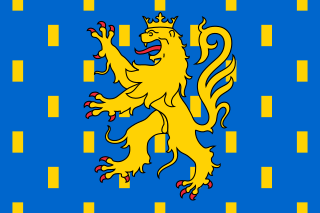
Franche-Comté is a cultural and historical region of eastern France. It is composed of the modern departments of Doubs, Jura, Haute-Saône and the Territoire de Belfort. In 2016, its population was 1,180,397.

Ain is a French department in the Auvergne-Rhône-Alpes region, Eastern France. Named after the Ain river, it is bordered by the Saône and Rhône rivers. Ain is located on the country's eastern edge, on the Swiss border, where it neighbours the cantons of Geneva and Vaud. In 2019, it had a population of 652,432.
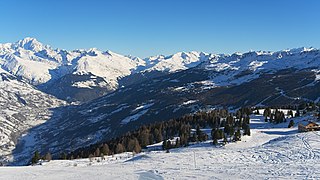
Savoie is a department in the Auvergne-Rhône-Alpes region, Southeastern France. Located in the French Alps, its prefecture is Chambéry. In 2019, Savoie had a population of 436,434.

The Jura Mountains are a sub-alpine mountain range a short distance north of the Western Alps and mainly demarcate a long part of the French–Swiss border. While the Jura range proper is located in France and Switzerland, the range continues as the Table Jura northeastwards through northern Switzerland and Germany.

Gex is a commune in the Ain department in eastern France and a subprefecture of the department.
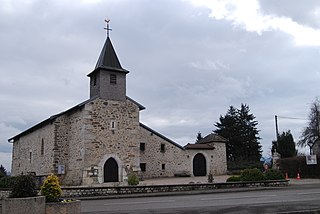
Ornex is a commune in the Ain department in eastern France.
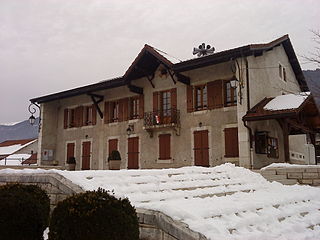
Crozet is a commune in the Ain department in eastern France.
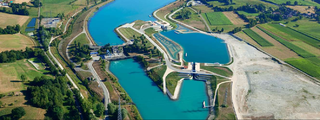
Anglefort is a commune in the department of Ain in the Auvergne-Rhône-Alpes region of eastern France.
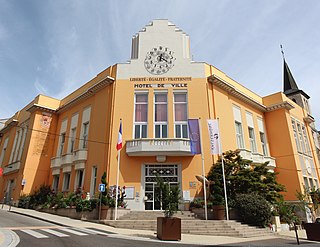
Bellegarde-sur-Valserine is a former commune in the Ain department in the Auvergne-Rhône-Alpes region in Eastern France. In 2019, it had a population of 11,326. On 1 January 2019, it was merged into the new commune of Valserhône.

Belleydoux is a commune in the Ain department in eastern France.

The arrondissement of Gex is an arrondissement of France in the Ain department in the Auvergne-Rhône-Alpes region. It approximately corresponds to the historical region of the Pays de Gex. It has 27 communes. Its population is 93,027 (2016), and its area is 404.9 km2 (156.3 sq mi).

The arrondissement of Nantua is an arrondissement of France in the Ain department in the Auvergne-Rhône-Alpes region. It has 62 communes. Its population is 93,404 (2016), and its area is 899.6 km2 (347.3 sq mi).

La Dôle is a mountain of the Jura, overlooking Lake Geneva in the westernmost part of the canton of Vaud. Rising to an altitude of 1677 meters, it is the second highest peak in the Swiss portion of the Jura, after Mont Tendre. Administratively, the summit is split between the municipalities of Gingins, Chéserex and La Rippe. The mountain is also close to and easily accessible from Saint-Cergue and the Col de la Givrine to the north, both above 1000 meters and connected to Nyon on Lake Geneva by road and by the Nyon–St-Cergue–Morez Railway. A paved road also climbs to the Chalet de la Dôle below the summit from Gingins.
The Route nationale 5, or RN 5, is a trunk road (nationale) in France now connecting Dijon with the frontier of Switzerland. It is also numbered the European route E21.
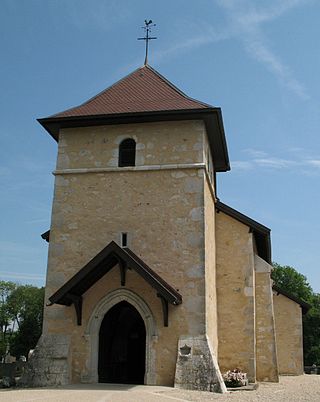
Saint-Genis-Pouilly is a commune in the Ain department within the Auvergne-Rhône-Alpes region of eastern France.

Col de la Faucille is a high mountain pass in the department of Ain in the French Jura Mountains. It connects the town of Gex in Ain to the towns of Les Rousses and Saint-Claude in the department of Jura.

Sergy is a commune in the Ain department in eastern France.

The river Valserine is a tributary of the Rhône that flows for 47.6 kilometres (29.6 mi) from the Col de la Faucille in the Jura Mountains to its confluence with the Rhône at Bellegarde-sur-Valserine. The Valserine Valley has great charm; it includes the Pont des Pierres that spans the river between Montanges and Mulaz, as well as the Pertes de la Valserine just north of Bellegarde-sur-Valserine, a canyon in which during the dry season the Valserine runs underground.

Parc naturel régional du Haut-Jura is a French regional natural park located in the southwest of the Jura Mountain Range in France, on the French-Swiss border.
Communauté d'agglomération du Pays de Gex is the communauté d'agglomération, an intercommunal structure, centred on the town of Gex. It is located in the Ain department, in the Auvergne-Rhône-Alpes region, eastern France. Created in 1995, the administrative seat is located in its namesake commune of Gex. Its area is 404.9 km2. Its population was 98,257 in 2019, of which 13,121 lived in Gex proper.






















